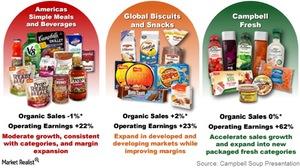Campbell Soup’s New Segments Impacted the Operating Profit
The Americas Simple Meals and Beverages segment reported operating earnings of $290 million—a rise of 22% compared to fiscal 2Q15.
Feb. 26 2016, Published 10:54 a.m. ET

Americas Simple Meals and Beverages
As we discussed in the last part, Campbell Soup (CPB) now reports for its three new segments. In this part, we’ll discuss how these segments performed and contributed to the operating profit.
The Americas Simple Meals and Beverages segment reported operating earnings of $290 million—a rise of 22% compared to fiscal 2Q15. A greater price realization and improved supply chain performance along with productivity improvements enhanced the gross margin percentage compared to fiscal 2Q15. The higher gross margin percentage drove the rise in operating earnings.
Global Biscuits and Snacks
The Global Biscuits and Snacks segment delivered operating earnings of $141 million—an increase of 23% compared to 2Q15. A higher gross margin percentage led by higher net price realization and productivity improvements, partly compensated by the adverse effect of currency translation and higher marketing expense, made the operating income rise.
Campbell Fresh
The Campbell Fresh segment demonstrated a 62% increase in operating earnings in fiscal 2Q16. It reported $21 million compared to fiscal 2Q15. A higher gross margin percentage led by improved supply chain performance, productivity improvements, and the favorable mix effect from growth in higher-margin refrigerated beverages contributed to the rise in operating earnings.
Campbell’s competitors in the industry include Keurig Green Mountain (GMCR), Treehouse Foods (THS), and Lancaster Colony (LANC). They reported gross margins of 28.6%, 21%, and 25.7%, respectively, for their last reported quarters. The PowerShares S&P MidCap Low Volatility Portfolio (XMLV) and the PowerShares DWA Consumer Staples Momentum Portfolio (PSL) invest 3.7% of their portfolios, respectively, in LANC stock as of February 25.
Next, we’ll discuss the revenue for the second quarter and what caused the decline in revenue. We’ll also look at the new segment’s contribution to the revenue.
